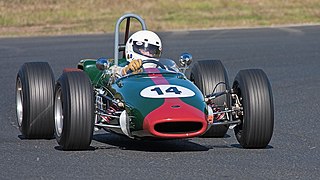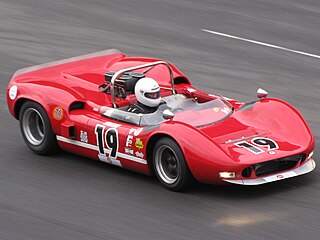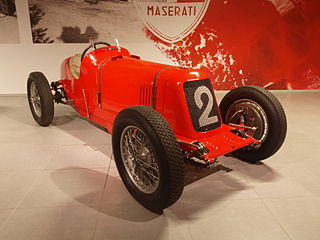Power-to-weight ratio is a calculation commonly applied to engines and mobile power sources to enable the comparison of one unit or design to another. Power-to-weight ratio is a measurement of actual performance of any engine or power source. It is also used as a measurement of performance of a vehicle as a whole, with the engine's power output being divided by the weight of the vehicle, to give a metric that is independent of the vehicle's size. Power-to-weight is often quoted by manufacturers at the peak value, but the actual value may vary in use and variations will affect performance.

The McLaren M6A was a Group 7 prototype race car designed and developed by driver Bruce McLaren, and built by his Bruce McLaren Motor Racing team for their entry in 1967 Can-Am season. As a replacement for the team's M1Bs from 1966, the Chevrolet-powered M6A's improved design earned Bruce McLaren and his team their first of multiple Can-Am championships. After the M6As were replaced by the M8A in preparation for 1968, McLaren and technical partner Trojan–Tauranac Racing developed the M6B which was sold to customers for use in Can-Am as well as other racing series.

The March 83G is a IMSA GTP/Group C sports prototype race car, designed, developed and built by British manufacturer and constructor March Engineering, for sports car racing, in 1983.

The Ralt RT4 is an open-wheel formula racing car, designed, developed and built by Ralt, for Formula Atlantic, in 1980. It was later converted into a closed-wheel prototype, and used in the revived Can-Am series, between 1982 and 1985, where it achieved only modest success. In Can-Am competition the car achieved 1 podium finish, 1 class victory and a best result of a 2nd-place finish.

The Brabham BT14 was an open-wheel mid-engined formula racing car, designed, developed and built by British manufacturer and constructor Brabham, in 1965. A total of 10 models were produced. It was specifically constructed to compete in Formula Libre racing. It competed in motor racing between 1965 and 1968; winning a total of 10 races, scoring 22 podium finishes, and clinching 4 pole positions. It also contested the 1967 European F2 Championship season, competing in 7 races, but with no success; scoring no wins, pole positions, podium finishes, or scoring any points. It was powered by a naturally-aspirated 1.6 L (98 cu in) Ford twin-cam four-cylinder engine, which droves the rear wheels through a conventional 4-speed manual transmission.
The Lola T160, and its evolution, the Lola T165, is a series of purpose-built Group 7 sports prototype race cars, designed and developed by British chassis manufacturer Lola Cars, specifically to compete in the Can-Am series in 1968. It was the successor to the competitive T70, sharing similar design knowledge and cues. Lola built the chassis, constructed out of fiberglass, and molded into an aluminum monocoque. This meant the car was light was lightweight, weighing only 670 kg (1,480 lb). The chassis was designed to accept a small-block engine, but most cars were powered by either the Chevrolet ZL1 or the Ford FE "big-block" motors, generating about 625–750 hp (466–559 kW); mated to a 4-speed or 5-speed Hewland L.G.500 or L.G.600 manual transmission. This made the cars very fast, with a notably excellent power-to-weight ratio. It was used in active competition until 1971, and was succeeded and used alongside the new T220 in 1970.
The Shadow DN2, also known as the Shadow Mk.III, is a purpose-built sports prototype race car, designed, developed and built by Shadow Racing Cars to Group 7 racing specifications, to compete in the Can-Am racing series, in 1972 and 1973. It was powered by an extremely powerful Chevrolet big-block engine, developing between 800–1,200 hp (600–890 kW), depending on boost pressure levels, and generating an asphalt-shredding 985 lb⋅ft (1,335 N⋅m) of torque The turbocharged system was used for three races, then the team switched back to a naturally aspirated engine, still producing 735 hp (548 kW); which was more than enough to get the job done.

The BRM P167 is a purpose-built sports prototype race car, designed, developed and built by British Racing Motors to Group 7 racing specifications, specifically to compete in the Can-Am racing series, between 1971. It was BRM's final Can-Am race car chassis. It was powered by a naturally aspirated, Chevrolet big-block engine, developing a solid 600 hp (450 kW).

The Cooper T23, formally called the Cooper Mk.II, is a Formula 2 racing car, built, designed, and developed by British manufacturer Cooper Cars in 1953. It also competed in Formula One, in 9 Grand Prix between 1953 and 1956. It was powered by the Bristol six-cylinder 2-litre engine.

The Brabham BT30 was an open-wheel Formula 2 racing car used in the 1969, 1970, and 1971 European Formula Two Championship.

The March 84G was a mid-engined Group C and IMSA racing sports prototype, designed and developed by March Engineering in late 1983 and used in sports car racing until 1989. It was powered by a number of different engines, including a Chevrolet small-block, a Buick V6, a Porsche flat-six, and even a Mazda 13B Wankel rotary engine. Power output was around 620 hp (460 kW). It only managed to score 5 wins, and clinch a total of 10 podium, over the course of 7 years and 119 race entries.

The Chevron B24 was a Formula 5000 racing car developed by Chevron Cars in 1972.

The McLaren M22 is an open-wheel race car, designed and developed by McLaren, to compete in Formula 5000 racing in 1972. Like it predecessors, The McLaren M22 was manufactured in large numbers. Built close to the weight limit, it was very light and was powered by a 500+ hp Chevrolet V8 engine. The cars were not actually manufactured by McLaren itself, but by the British racing car manufacturer Trojan, as with previous models. This would turn out to be the last Trojan-built McLaren F5000 car.

The Brabham BT5, and its evolution, the Brabham BT8, are sports racing cars manufactured and developed by Brabham in 1963 (BT5) and 1964 (BT8), respectively. It won a total of 4 races, and achieved 10 podium finishes.

The McLaren M1A, and its derivatives, the McLaren M1B and the McLaren M1C, are a series of mid-engined Group 7 sports prototype race cars built by McLaren, between 1963 and 1968. The M1A was the team's first self-designed and developed sports car. Later versions, such as the 'M1B' and 'M1C', competed and raced in the North American Can-Am series, starting in 1966 season. The car was raced in North America and Europe in 1963 and 1964 in various Group 7 and United States Road Racing Championship series events. 24 examples of the M1A and M1B were built, and 25 examples of the M1C were manufactured. They were powered by a few different motors, including Chevrolet small-block engine, an Oldsmobile V8 engine, a Chevrolet big-block engine, and even a Ford FE engine. It was constructed out of a tubular space frame chassis, and, combined with its light weight of 551 kg (1,215 lb) this gave it a great power-to-weight ratio. The 4.5 L (270 cu in) Oldsmobile V8 engine developed around 310 hp (230 kW), while the 350 cu in (5.7 L) Chevrolet small-block V8 engine was capable of developing over 550 hp (410 kW), and 538 lb⋅ft (729 N⋅m) of torque. This drove the rear wheels through a Hewland L.G.500 four-speed manual transmission.

The VDS-001 was an American closed-wheel sports prototype race car, designed, developed, and built by Racing Team VDS for the revived Can-Am series, in 1981. It is based on the Lola T530. Geoff Brabham won the 1981 Can-Am Championship with the car, despite only winning 2 of the 10 races that season. It won a further 4 races in 1982 Can-Am Championship in 1982, being driven by Al Holbert. It was later exported to England, where it competed in the British Thundersports series, and achieved great success. Its sports car racing career spanned 9 years (1981-1988), and over that period of time, it won a total of 19 races, achieved a total of 26 podium finishes, and scored 21 pole positions. As with most Can-Am cars of the time, it was powered by a 5.0 L (310 cu in) Chevrolet small-block motor.
The McKee Mk.7, also designated as the McKee Mk.VII, is a special purpose-built American sports prototype race car, designed and developed by Bob Nagel, and built to Group 7 specifications, for the Can-Am series, in 1967. It won a total of 2 races, and achieved 4 podium finishes. The configuration is a mid-engine, rear-wheel-drive layout. The chassis is constructed out of a tubular space frame, wrapped in a fiberglass body. The powerplant that was used varied, but included a Chevrolet small-block, a Chevrolet big-block, an Oldsmobile V8, and even a Ford FE big-block engine.

The Maserati 4CM is an open-wheel Grand Prix motor racing car, designed, developed and built by Italian manufacturer Maserati, in 1931.
The March 82G is a IMSA GTP/Group C sports prototype race car, designed, developed and built by British manufacturer and constructor March Engineering, for sports car racing, in 1982. It competed in motor racing between 1982 and 1986, but only scored 1 race win, 8 podium finishes, and 2 pole positions. It was powered by a naturally-aspirated 620 hp (460 kW) 5.7 L (350 cu in) Chevrolet V8 engine.
The Lola T220, and its evolution, the Lola T222, are Group 7 sports prototype race cars, designed, developed, and built by the British manufacturer and constructor Lola, to compete in the Can-Am championship from the 1971 season. It also took part in the European Interserie championship.














